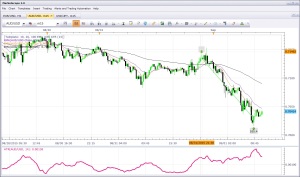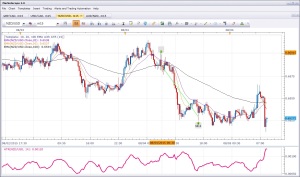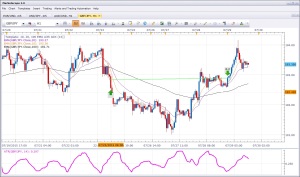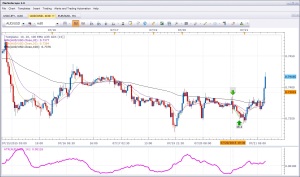I had this trade running at the same time as my GBPJPY trade, which presented a problem. I’m trading with margin, meaning each position locks up a portion of my account. My account size of $100 does not allow for a large number of open positions, especially if they all move against me at the same time, and drawdown the whole account. With a small account and multiple open positions, there is a risk that available margin can dry up when the market moves against my positions. In this case, I would get called on all positions by FXCM and they would automatically close everything out at market rates.
This is called “blowing out your account”, and has happened to me once or twice in the past.
Again, the reasoning for each position was sound. I was confident, but ready to be wrong.
Here is the USDCAD trade:

On July 14 at market open in Toronto, I bought (2) lots at 1.2760, near major resistance at 1.2800 (third approach at this level in 2015). The daily range was about 100 pips, and intraday was about 50. I put a mental stop at 1.2640, and a mental take profit at 1.2990. The entry, stop loss, and take profit numbers all came directly from Jarratt Davis’ blog.
Market Sentiment
Same as the GBPJPY trade from July 14.
Market Fundamentals
- USD: the Federal Reserve is expected to be the next Central Bank to raise Interest Rates (possibly Sept 2015); FOMC wants to see data on the economy improving, and the global situation could push back plans for Interest Rate hikes; near long term highs against many other currencies; the most bullish currency right now
- CAD: poor GDP data in April, and 4 months of contraction; half of analysts expecting an Interest Rate cut on July 15 from 0.75% to 0.50%, or at least some more dovish tones; new oil supply from Iran is not a huge factor until their production and distribution are fully functional, but sentiment is heavily against CAD right now and traders are looking for a reason to sell it
Trading Plan: position for CAD weakness on BOC Rate Statement on July 15, against USD strength on meeting data expectations and maintaining plans for Interest Rate hikes this year.
Result: USDCAD was near a 4-month high when I bought on July 14. Later that day, USD had a slight miss on Retail Sales figures, and USDCAD dropped about 40 pips against me. Then on July 15, at 8:00am on the dot, the Bank of Canada cut Interest Rates to 0.50% and USDCAD shot up above 1.2900. I found out later that Fed Chair Yellen was testifying at the same time, re-affirming Fed plans to proceed with Interest Rate hikes this year. Both of my USDCAD lots were 150 pips in the money by 8:01am, and I closed them both immediately.
Comments: It may seem like gambling to “bet” on the effect of a data release. And if I were blindly guessing at an outcome and relying on luck, it would indeed be betting. This is the best trade of my life so far. Agreed, it was Jarratt’s idea in the first place, but I understand every speck of Fundamental, Sentiment, and Technical strategy in this position, which is what this blog is about.










